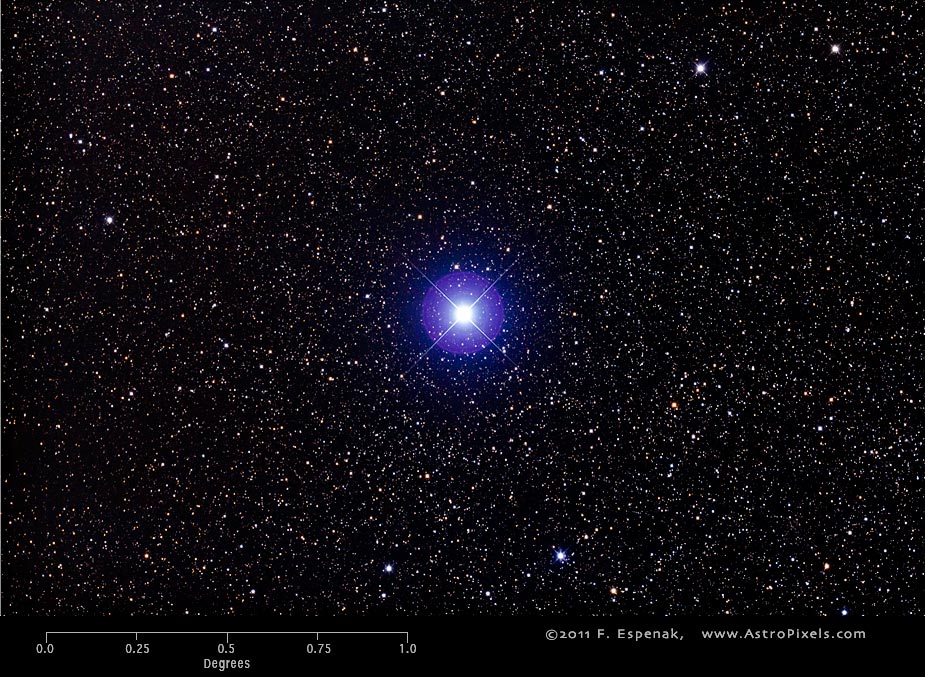Elnath
Elnath or Beta Tauri (Bet Tau) is the 2nd brightest naked eye star in the constellation Taurus. With an apparent magnitude of 1.65, Elnath is the 27th brightest star in the entire sky (see: 50 Brightest Stars ). Its absolute magnitude is -1.37 and its distance is 131 light years.The Equinox J2000 equatorial coordinates are RA = 05h 26m 17.5s, Dec = +28° 36' 27".
Elnath has a spectral type of B7III, a surface temperature of 13,600° Kelvin and a luminosity 700 times the Sun. It has a mass of 4.5 solar masses and a diameter 5.5 times the Sun.
The image above shows the uncropped view of Elnath (North is up) through the Takahashi E-180 Astrograph.
Elnath's absolute magnitude is -1.34, similar to another Taurean star, Maia in the Pleiadian star cluster. Like Maia, Elnath is a B class giant with a luminosity 700 times solar. However being approximately 130 light years distant compared to Maia's estimated 360 light years, Elnath ranks as the second brightest star in Taurus.
Uniquely positioned along the plane of our Milky Way Galaxy a few degrees west of the galactic anticenter, Elnath heralds a rich collection of nebulae and star clusters. Relative to our Sun, Beta Tauri is notable for a high abundance of manganese, but little calcium and magnesium. This star has begun to evolve away from the main sequence.
Situated close to the ecliptic, this star can be occulted by the Moon. Such occultations occur when the Moon's ascending node is near the Vernal Equinox, as is the case in 2007. Most occultations are visible only in parts of the Southern Hemisphere, because the star lies at the northern edge of the lunar occultation zone. Rarely, it may be occulted as far north as southern California.
There is a faint star that appears close enough to Elnath for astronomers to consider it a double star. Its visual companion, known as BD+28 795B, has a PA of 239 degrees and is separated from the main star by 33.4 arcseconds.
The description above is based on the Elnath entry in Wikipedia.For more information about Elnath, see Stars (Jim Kaler).
Technical Details
- Object: Elnath
- Other Names: Beta Tauri, HR1791, HD35497, HIP25428
- Object Type: bright star
- Object Data: Apparent Magnitude = 1.65, Absolute Magnitude = -1.37, distance = 131 light years
- Object Position (Equinox J2000): RA = 05h 26m 17.5s, Dec = +28° 36' 27", Constellation = Taurus
- Date/Time: 2011 Dec 29 07:01:29 UTC
- Location: Bifrost Astronomical Observatory, Portal, AZ
- Mount: Astro-Physics 1200GTO
- Telescope: Takahashi Epsilon 180 Hyperbolic Astrograph
- Camera: Canon EOS 550D (Rebel T2i) (modified with a Baader UV/IR filter)
- Field of View: 1.70° x 2.56° at 1.7 arc-sec/pixel (web version: 10.0 arc-sec/pixel)
- Exposure: 2 x 240s, f/2.8, ISO 800
- File Name: Elnath-01w.jpg
- Processing (Adobe Camera Raw): Graduated Filter, Vignetting Correction, Noise Reduction, White Balance, Curves
- Processing (Photoshop CS5): Average Images, Curves, Noise Reduction
- Original Image Size: 3454 × 5179 pixels (17.9 MP); 11.5" x 17.3" @ 300 dpi
- Rights: Copyright 2011 by Fred Espenak. All Rights Reserved. See: Image Licensing.
